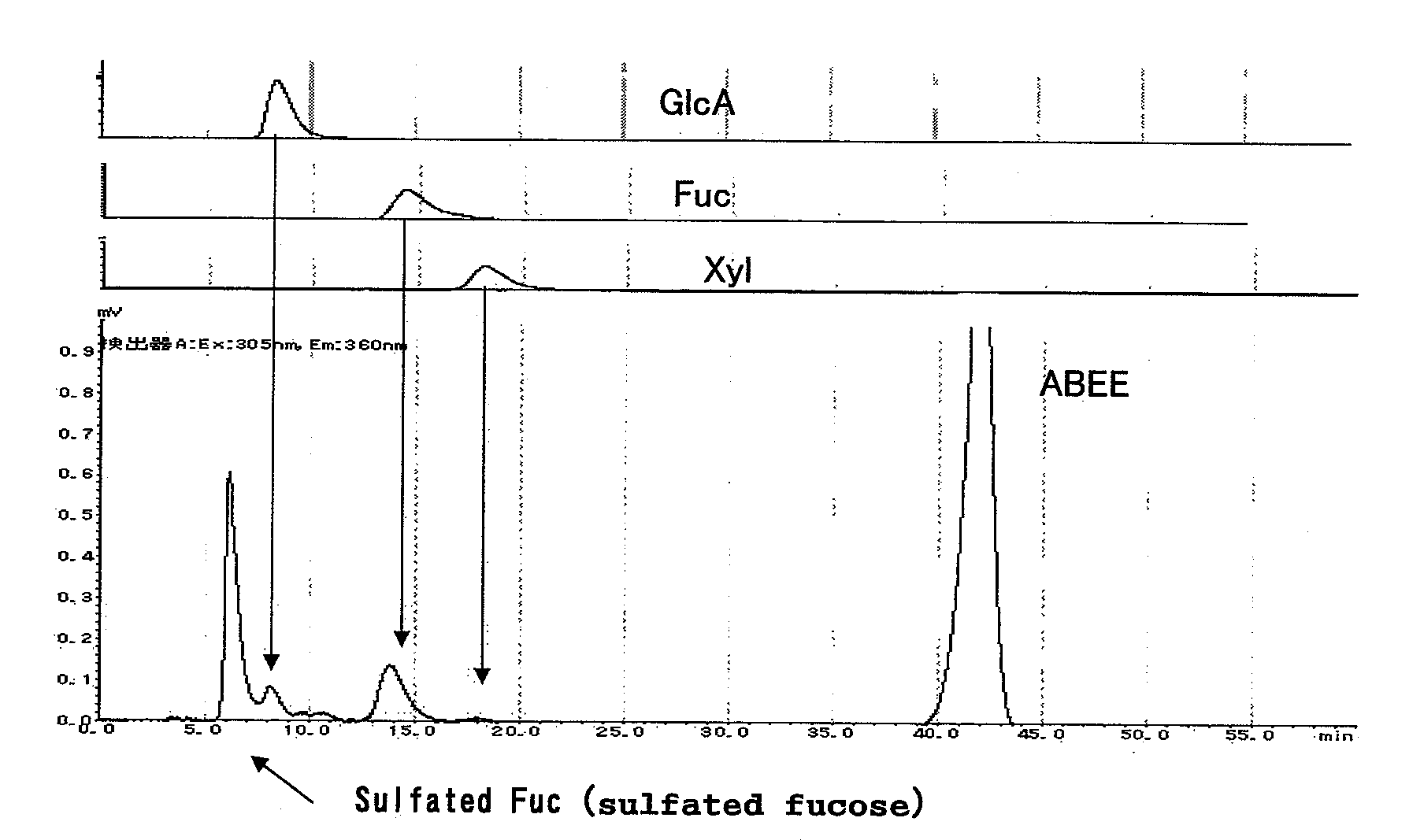Oligosaccharides derived from fucoidan
a technology of oligosaccharides and fucoidan, which is applied in the field of oligosaccharides derived from fucoidan, can solve the problems of limited use of fucoidan in food, unknowing exactly which fucoidan is used, and poor taste, and achieves good taste and high safety
- Summary
- Abstract
- Description
- Claims
- Application Information
AI Technical Summary
Benefits of technology
Problems solved by technology
Method used
Image
Examples
example 1
Preparation of Fucoidan Oligosaccharide-1
a) Preparation of Fucoidan Fraction
[0103]To 100 g of Okinawa Nemacystus decipiens, 1000 ml of distilled water was added, and extraction was conducted at 100° C. for 1 hour. The obtained extract was cooled, and then filtered by suction, electrodialyzed (desalinated), and lyophilized to obtain 2 g of fucoidan fractions. This fucoidan was hydrolyzed with an aqueous solution containing 2NH2SO4 at 100° C. for 1 hour. The obtained aqueous solution was neutralized by 2 N NaOH, and fluorescently labeled by ABEE to prepare a monosaccharide analysis sample. It was confirmed that the composition of the constituent sugars was sulfated fucose:glucuronic acid:fucose:xylose=49.3:4.9:12.1:1 (FIG. 1).
Column: Cosmosil C18 AR-II (4.6 mmφ×250 mm)
Mobile phase: 0.2 M potassium borate buffer containing 10% acetonitrile
Flow rate: 1.0 ml / min.
Temperature: 45° C.
[0104]Detection: fluorescence detector (Shimadzu Corporation), Ex: 305 nm, Em: 360 nm
b) Hydrolysis of Fucoid...
example 2
Preparation of Fucoidan Oligosaccharide-2
[0111]To 100 g of Okinawa Nemacystus decipiens, 1000 ml of 2 N HCl was added, and the mixture was subjected to acid hydrolysis at 50° C. to 100° C. for 1 hour. The obtained extract was cooled, and then filtered by suction, electrodialyzed (desalinated), and lyophilized to obtain 2 g of fucoidan fractions. The fucoidan fractions were fluorescently labeled by ABEE, and then analyzed by ESI-MS (4000Q TRAP LC / MS / MS system (Applied Biosystems); analysis conditions, Polarity: Negative ion mode; Declustering Potential: −50 v; Collision energy: −10 eV; Temperature: 550° C.). As a result, a chart shown by FIG. 28 was obtained, and the existences of fucoidan oligosaccharides represented by formulae (I) to (XI) were confirmed.
example 3
Preparation of Sulfated Fucose-Free Fucoidan Oligosaccharide
[0112]1. Fucoidan (10 g, Okinawa Hakko Kagaku, Japan) was added to 200 ml of 1 N HCl and hydrolyzed at 70° C. to 105° C. for 15 to 30 minutes while stirring in a medium bottle.
2. After cooling, the hydrolysate was neutralized with NaOH and filtered. When filtration took a long time, centrifugation was performed for solid-liquid separation, and the liquid phase was then filtered.
3. To the filtrate, powdered activated carbon was added and stirred at ordinary temperature for 15 minutes, followed by filtration through a 0.45 μm Millipore filter to remove the activated carbon.
4. Using a Micro Acilyzer G3 (Asahi Kasei Corporation, Japan), desalination was performed with an AC110 membrane to reach a constant conductivity.
5. To 100 ml of a strongly acidic cation exchange resin Diaion SK1B (H-type, Mitsubishi Chemical Corporation, Japan), the whole volume (about 300 ml) was loaded and then washed with water (100 ml) to collect the e...
PUM
| Property | Measurement | Unit |
|---|---|---|
| volume | aaaaa | aaaaa |
| volume | aaaaa | aaaaa |
| volume | aaaaa | aaaaa |
Abstract
Description
Claims
Application Information
 Login to View More
Login to View More - R&D
- Intellectual Property
- Life Sciences
- Materials
- Tech Scout
- Unparalleled Data Quality
- Higher Quality Content
- 60% Fewer Hallucinations
Browse by: Latest US Patents, China's latest patents, Technical Efficacy Thesaurus, Application Domain, Technology Topic, Popular Technical Reports.
© 2025 PatSnap. All rights reserved.Legal|Privacy policy|Modern Slavery Act Transparency Statement|Sitemap|About US| Contact US: help@patsnap.com



